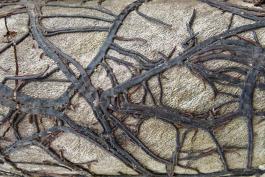
Honey-colored, sticky cap with black hairs over the center; stalk has whitish ring. Grows in clusters at the bases of trees or stumps and over buried wood. August–November. Cap convex, then flattened and centrally depressed; yellow to honey to rusty brown; texture sticky with black hairy scales in center. Gills narrow; spacing distant; whitish, becoming darker with age; gills attached or slightly descending. Stalk thick; whitish, becoming reddish brown; texture fibrous; has ring on upper stalk. Grows in clusters with stalks fused at the base. Partial veil leaving a whitish ring on stalk. Spore print white. Spores magnified are elliptical, smooth, colorless.
Lookalikes: Ringless honey mushroom (Desarmillaria caespitosa) has a dry cap and no ring. Jack-o’-lantern (Omphalotus illudens) is orange. Big laughing gym (Gymnopilus junonius) is orange, bitter, with orange-brown spores. Deadly galerina (Galerina marginata) is smaller with a smooth cap and brown spores.
Cap width: 1–6 inches; stalk length: 2–6 inches; stalk width: ¼–¾ inch.

Statewide.
Habitat and Conservation
Grows in clusters at the bases of trees or stumps, especially oaks, and over buried wood, often arising after autumn rains. This species parasitizes trees, sometimes killing their hosts. Even after the tree has been cut and removed, the mushrooms can arise seasonally from the stump.
Status
Considered a good edible when young and fresh. It causes stomach upset in some individuals. The first time you eat it, try just a small amount, and make sure it is cooked thoroughly.
Life Cycle
This species is parasitic on trees and sometimes kills the host, causing root rot. An early symptom is dieback in the crown and branches. It produces long, black, stringy cords, or rhizomorphs, which form under the bark of infected trees or in the soil. These strands can travel long distances and produce mushrooms on trees far from the original host. As with other parasites, young, newly transplanted, injured, or stressed trees are most vulnerable.
Human Connections
Humans have eaten mushrooms for thousands of years, in many cultures, for various purposes. Sometimes they are eaten for their nutritional and culinary value; sometimes they are considered medicinal. Be absolutely sure of your identifications before you consume wild mushrooms!
Ecosystem Connections
A long time ago, fungi were considered plants, which seemed obvious since they don't move and often grow "rooted" in soil. Today they constitute their own separate kingdom. Unlike plants, they cannot photosynthesize. Like animals, they must digest food from elsewhere.
The honey mushroom is in the same genus as the “humongous fungus,” an Armillaria mycelium that is over 2.5 square miles in size! One specimen is estimated to be more than 450 years old.






Mushrooms are a lot like plants, but they lack chlorophyll and have to take nutrients from other materials. Mushrooms are neither plants nor animals. They are in a different kingdom — the fungi. Fungi include the familiar mushroom-forming species, plus the yeasts, molds, smuts, and rusts.
Always be cautious when eating edible mushrooms. Be absolutely sure of the ID, and only eat a small amount the first time you try it to avoid a reaction..





















